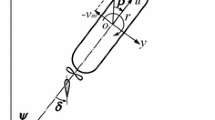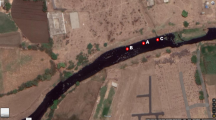Abstract
The desire to benefit from economy of scale is one of the major driving forces behind the continuous growth in ship sizes. However, models of new large ships need to be thoroughly investigated to determine the carrier’s response in waves. In this work, experimental and numerical assessments of the motion and load response of a 550,000 DWT ore carrier are performed using prototype ships with softer stiffness, and towing tank tests are conducted using a segmented model with two schemes of softer stiffness. Numerical analyses are performed employing both rigid body and linear hydroelasticity theories using an in-house program and a comparison is then made between experimental and numerical results to establish the influence of stiffness on the ore carrier’s springing response. Results show that softer stiffness models can be used when studying the springing response of ships in waves.
Similar content being viewed by others
References
ABS, 2010. Guidance notes on springing assessment for container carriers. ABS.
Barhoumi M, Storhaug G, 2014. Assessment of whipping and springing on a large container vessel. International Journal of Naval Architecture and Ocean Engineering, 6(2), 442–458. DOI: 10.2478/IJNAOE-2013-0191
Bishop RED, Price WG, 1979. Hydroelasticity of ships. Cambridge University Press, Cambridge, UK.
Bishop RED, Price WG, 1983. An introduction to ship hydroelasticity. Journal of Sound and Vibration, 87(3), 391–407. DOI: 10.1016/0022-460X(83)90469-8
Bishop RED, Price WG, Wu YS, 1986. A general linear hydroelasticity theory of floating structures moving in a seaway. Phil. Trans. R. Soc. Lond. A, 316, 375–426. DOI: 10.1098/rsta.1986.0016.
Chen ZY, Ren HL, Li H, Zhang KH, 2012. Experimental and numerical analysis of bow slamming and whipping in different sea states. Journal of Ship Mechanics, 16(3), 246–253.
Choi JH, Jung BH, Lee YW, Bigot F, Malenica S, Chung YS, 2010. Evaluation of springing-induced hull girder loads for ultra large containership and ore carrier. Proceedings of the 20th International Offshore and Polar Engineering Conference, Beijing, China.
Cui WC, Yang JM, Wu YS, Liu YZ, 2007. Theory of hydroelasticity and its application to very large floating structures. Shanghai Jiao Tong University Press, Shanghai, China.
Dai YS, 1998. Potential flow theory of ship motions in waves in frequency and time domain. National Defence Industry Press, Beijing. (in Chinese)
Hirdaris SE, Bai W, Dessi D, Ergin A, Gu X, Hermundstad OA, Huijsmans R, Iijima K, Nielsen UD, Parunov J, Fonseca N, Papanikolaou A, Argyriadis K, Incecik A, 2014. Loads for use in the design of ships and offshore structures. Ocean Engineering, 78, 131–174. DOI: 10.1016/j.oceaneng.2013.09.012
Hirdaris SE, Bakkers N, White N, Temarel P, 2009. Service factor assessment of a great lakes bulk carrier incorporating the effects of hydroelasticity. Marine Technology, 46(2), 116–121.
Hirdaris SE, Miao SH, Price WG, Temarel P, 2006. The influence of structural modelling on the dynamic behaviour of a bulker in waves. Proceedings of the 4th International Conference on Hydroelasticity in Marine Technology, Wuxi, China, National Defense Industry Press, Beijing, China.
Hirdaris SE, Price WG, Temarel P, 2003. Two-and three-dimensional hydroelastic modelling of a bulker in regular waves. Marine Structures, 16(8), 627–658. DOI: 10.1016/j.marstruc.2004.01.005
Hirdaris SE, Temarel P, 2009. Hydroelasticity of ships: recent advances and future trends. Proceedings of the Institution of Mechanical Engineers, Part M: Journal of Engineering for the Maritime Environment, 223(3), 305–330. DOI: 10.1243/14750902JEME160
Hong SY, Kim BW, 2014. Experimental investigations of higher-order springing and whipping-WILS project. International Journal of Naval Architecture and Ocean Engineering, 6(4), 1160–1181. DOI: 10.2478/IJNAOE-2013-0237
Hong SY, Kim BW and Nam BW, 2012. Experimental study on torsion springing and whipping of a large container ship. International Journal of Offshore and Polar Engineering, 22(2), 97–107.
Hong SY, Kim KH, Kim BW, Kim YS, 2015. Characteristics of bow-flare slamming loads on an ultra-large containership in irregular waves. Proceedings of the 25th International Offshore and Polar Engineering Conference, Kona, Big Island, Hawaii, USA.
Hu JJ, Wu YS, Tian C, Wang XL, Zhang F, 2012. Hydroelastic analysis and model tests on the structural responses and fatigue behaviours of an ultra-large ore carrier in waves. Proceedings of the Institution of Mechanical Engineers, Part M: Journal of Engineering for the Maritime Environment, 226(2), 135–155. DOI: 10.1177/1475090211430303
ISSC, 2012. Report of technical committee II.2: Dynamic response. Proceedings of the 18th International Ship and Offshore Structures Congress, Rostock, Germany.
Jang CD, Jung JJ, Korobkin AA, 2007. An approach to estimating the hull girder response of a ship due to springing. Journal of Marine Science and Technology, 12, 95–101. DOI: 10.1007/s00773-007-0242-0
Kim SP, Yu HC, Hong SY, 2010. Segmented model testing and numerical analysis of wave-induced extreme and springing loads on large container carriers. Proceedings of the 20th International Offshore and Polar Engineering Conference, Beijing, China.
Kim Y, Kim KH, Kim Y, 2009. Analysis of hydroelasticity of floating shiplike structure in time domain using a fully coupled hybrid BEM-FEM. Journal of Ship Research, 53(1), 31–47.
Korobkin AA, Parau EI, Vanden-Broeck JM, 2011. The mathematical challenges and modelling of hydroelasticity. Phil. Trans. R. Soc. Lond. A, 369, 2803–2812. DOI: 10.1098/rsta.2011.0116
Lee Y, Wang Z, White N, Hirdaris SE, 2011. Time domain analysis of springing and whipping responses acting on a large container ship. Proceedings of the ASME 2011 30th International Conference on Ocean, Offshore and Arctic Engineering, Rotterdam, The Netherlands, 1–9.
Li H, 2009. 3-D Hydroelasticity analysis method for wave loads of ships. PhD thesis, Harbin Engineering University. (in Chinese)
Miyake R, Matsumoto T, Yamamoto N, Toyoda K, 2010. On the estimation of hydroelastic response acting on a ultra-large container ship. Proceedings of the 20th International Offshore and Polar Engineering Conference, Beijing, China, 849–856.
Miyake R, Matsumoto T, Zhu T, Usami A, Dobashi H, 2009. Experimental studies on the hydroelastic response using a flexible mega-container ship model. Hydroelasticity in Marine Technology, University of Southampton, UK, 161–171.
Newman JN, 1994. Wave effects on deformable bodies. Applied Ocean Research, 16, 47–59. DOI: 10.1016/0141-1187(94)90013-2
Senjanovic I, Malenica S, Tomasevic S, 2008. Investigation of ship hydroelasticity. Ocean Engineering, 35, 523–535. DOI: 10.1016/j.oceaneng.2007.11.008
Shin KH, Jo JW, Hirdaris SE, Jeong SG, Park JB, Lin F, Wang Z, White N, 2015. Two-and three-dimensional springing analysis of a 16,000 TEU container ship in regular waves. Ships and Offshore Structures, 10(5), 498–509. DOI: 10.1080/17445302.2015.1014255
Skjørdal SO, Faltinsen OM, 1980. A linear theory of springing. Journal of Ship Research, 24(2), 74–84.
Temarel P and Hirdaris SE, Eds., 2009. Hydroelasticity in marine technology. Proceedings of the 5th International Conference HYELAS’09, University of Southampton, Southampton, UK.
Wu YS, Cui WC, 2009. Advances in the three-dimensional hydroelasticity of ships. Proceedings of the Institution of Mechanical Engineers, Part M: Journal of Engineering for the Maritime Environment, 223(3), 331–348. DOI: 10.1243/14750902JEME159
Author information
Authors and Affiliations
Corresponding author
Additional information
Foundation item: Supported by the National Natural Science Foundation of China (Grant No. 51079034), and the National Basic Research Program of China (Grant No. 2011CB013703)
Rights and permissions
About this article
Cite this article
Adenya, C.A., Ren, H., Li, H. et al. Estimation of springing response for 550 000 DWT ore carrier. J. Marine. Sci. Appl. 15, 260–268 (2016). https://doi.org/10.1007/s11804-016-1365-7
Received:
Accepted:
Published:
Issue Date:
DOI: https://doi.org/10.1007/s11804-016-1365-7




